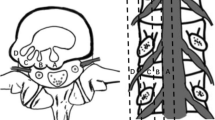Abstract
The aim of this study was to determine MRI findings in patients successfully operated upon for lumbar disc herniation. We investigated 20 patients with a successful outcome after L4-5 or L5-S1 disc operations clinically and with MRI preoperatively, and at 5 days, 6 weeks, and 4 months after surgery. Postoperatively, T1- and T2-weighted images were obtained. At 4 months gadolinium-enhanced images were added. Pronounced intraspinal MRI changes were seen during follow-up. Deformation of the dural sac was seen in 13 patients preoperatively, in 19 at 5 days after operation, in 15 at 6 weeks, and in 12 at 4 months. Nerve root involvement was seen in all cases both preoperatively and at 5 days after operation, in 17 at 6 weeks, and in 15 at 4 months. No correlation between symptoms or the straight leg raising test and the size or nature of the abnormal tissue in the spinal canal postoperatively could be demonstrated. It was concluded that early postoperative MRI after lumbar discectomy must be interpreted carefully, and that oedema and scar formation are probable reasons for difficulties in interpretation.
Similar content being viewed by others
References
Montaldi S, Fankhauser H, Schnyder P, de Tribolet N (1988) Computed tomography of the postoperative intervertebral disc and lumbar spinal canal: investigation of twenty-five patients after successful operation for lumbar disk herniation. Neurosurgery 22:1014–1022
Boden SD, Davis DO, Dina TS, Parker CP, O'Malley S, Sunner JL, Wiesel SW (1992) Contrast-enhanced MR imaging performed after successful lumbar disk surgery: prospective study. Radiology 182:59–64
Aprill C, Bogduk N (1992) High-intensity zone: a diagnostic sign of painful lumbar disc on magnetic resonance imaging. Br J Radiol 65:361–369
Ross J, Modic MT, Masaryk TJ, Carter J, Marcus RE, Bohlman H (1989) Assessment of extradural degenerative disease with Gd-DTPA-enhanced MR imaging: correlation with surgical and pathologic findings. AJNR 10:1243–1249
Strömqvist B, Jönsson B, Annertz M, Holtås (1991) Cauda equina syndrome caused by migrating fat graft after lumbar spinal decompression. A case report demonstrated with MRI. Spine 16:100–101
Cervellini P, Curri D, Volpin L, Bernardi L, Pinna V, Benedetti A (1988) Computed tomography of epidural fibrosis after discectomy: a comparison between symptomatic and asymptomatic patients. Neurosurgery 23:710–713
Ross J, Modic MT, Masaryk TJ (1989) Tears of the anulus fibrosus: assessment with Gd-DTPA-enhanced MR imaging. AJNR 10:1251–1254
Annertz M, Hägglund G, Holtås S, Jönssen B, Strömqvist B (1992) Contrast-enhanced MRI versus myelography and contrast-enhanced CT in postdiskectomy problems. Eur Spine J 1:84–88
Yu S, Sether LA, Ho PSP, Wagner M, Haughton VM (1988) Tears of the annulus fibrosus: correlation between MR and pathologic findings in cadavers. AJNR 9:367–370
Masaryk TJ, Ross JS, Modic MT, Boumphrey F, Bohlman H, Wilber G (1988) High-resolution MR imaging of sequestered lumbar intervertebral disks. AJNR 9:351–358
Author information
Authors and Affiliations
Rights and permissions
About this article
Cite this article
Annertz, M., Jönsson, B., Strömqvist, B. et al. Serial MRI in the early postoperative period after lumbar discectomy. Neuroradiology 37, 177–182 (1995). https://doi.org/10.1007/BF01578253
Issue Date:
DOI: https://doi.org/10.1007/BF01578253




